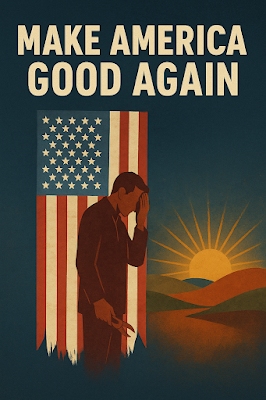MAKE AMERICA GOOD AGAIN
America thrives when it leads with values—not deals. But lately, we've flipped that on its head. Everything's a transaction. Integrity, alliances, truth, even leadership—it’s all for sale. And Trump didn’t just walk into that system. He became its poster child.
The markets, our retirement accounts, our economy, and people’s jobs are all being held hostage by the chaos he represents.
Alliances are crumbling—Europe, Japan, Taiwan, South Korea. Our market is holding its breath.
We didn’t earn our global leadership by bullying or cutting the best deal. After WWII, we provided security. We rebuilt Europe and Japan. We showed up with values. And in return, we got trust, alliances—and yes, the reserve currency. That wasn’t charity. It was leadership. And it worked.
Today? Trump has ripped that all up.
Other countries aren’t just sitting around cheering us on as their economies suffer. They’re not saying, “Go ahead, America! Yay!” No—they’re preparing to move on without us. And who can blame them?
Trump wants to blow it all up. He hates the old deals because they didn’t serve him. He wants new ones—with himself at the center. No principles, no norms—just loyalty.
Look at his pick for Surgeon General—maybe already confirmed—famous for TikToks, not medical degrees.
RFK Jr. isn’t any better. He surrounds himself with influencers, pseudoscientists, and conspiracy theorists. Trump’s presidency? One giant conspiracy theory, spun into memes and sold as truth. There’s no expertise. No grounding. Just chaos.
But the bigger issue? There are no values. Or worse—the deal has become the value.
One of Trump’s ideas? Take Canada and Greenland.
Maybe we do need missile stations across the Arctic. Let’s give him the benefit of the doubt. But instead of diplomacy, he storms in like a thug. He and his family stomp around like a crime syndicate demanding tribute. And the world says: “No thanks.”
You don’t have to agree they're a crime family. But they’ve been banned from running charities for robbing them blind. Trump’s facing dozens of felony charges. He’s raking in crypto cash from mystery sources. Secret deals, backroom arrangements, shady donors. He’s the most corrupt president we’ve ever had. Period.
Even if we did need Greenland and Canada, his approach guarantees we won’t get them. Values might have worked. Respect, history, diplomacy. But not this.
I’ve lost my religion. I’ve lost my political party. However, one belief remains: we must replace deals with values.
Now I get it. “Values” sounds old-fashioned. Snooty. Holier-than-thou. People say, “We want to win!” like Charlie Sheen on a bender.
But America didn’t win because it was ruthless. We won because we were good. If we stop being good, we stop being great.
You can’t “Make America Great Again.” You can only make America good again. And that’s better.
We’ve got the tail wagging the dog.
So what do I mean by values? In a time of pedophile priests and Christian nationalists, it’s a fair question. Here's a start:
-
Trade with democracies.
-
Respect the rule of law.
-
Stand for freedom of the press.
-
Stand for freedom of religion.
And let our tariffs and treaties be based on objective criteria, not backroom deals.
Corruption, nepotism, rot, everything broken today comes from those deals.
Someone said DEI should’ve been branded “anti-nepotism.” They’re right. The real problem isn’t diversity. It’s legacy. Rich kids coasting on last names. “Oh, you went to Harvard? Then your kid’s in, too. Forever.”
That’s our ruling class. And they’re no better than Trump.
They say they hate him, but their system’s just as rigged. We pretend we have a meritocracy. We don’t.
It’s like our health care. We say it’s a “free market.” But we don’t see prices. We don’t have choices. We’ve got insurance companies—not innovators, just risk managers. And 5,000 State Farm ads with Jake and a carousel of celebrities.
Do we get healthy? No. We get commercials. We get call centers and claims denied. It’s a scam—just like everything else built on deals.
No prices. No options. No real market. Just more deals for insiders.
This is America’s problem: we have deals. We don’t have values.
Trump literally wrote The Art of the Deal. Everything he touches turns to crap. The Midas touch—but reversed. He bankrupts businesses. He bankrupts trust. But he’s entertaining, and for some, that’s enough.
He drains the oxygen from every room. He is a narcissistic, corrupt embodiment of every bad stereotype the world believes about America.
Our attention spans? Sold off. Big Tech and media auction our minds off minute by minute. It's manipulation, rooted in propaganda. Freud’s nephew helped invent the system. Now it's everywhere.
The Social Dilemma laid it bare. Our feeds are rigged. Our outrage is harvested. Our democracy is hacked. And Trump? He’s the algorithm’s perfect storm.
His “family values”? Paying off pornstars. Praying in public—exactly what Jesus told us not to do.
Jesus said: when you pray, go in private. Trump gets circled by grifters laying hands on him like he’s a prophet. They ignore what Jesus taught. They wave their religion like a flag and claim righteousness while cashing in.
They’ve made their deal. And they have their reward.
But we don’t have to keep doing this.
We can say no. We can call it what it is. We can ostracize the manipulators, the con men, the phony patriots. We can choose humility over hubris. Respect over domination. Negotiation over threats.
We can make America humble. Make it just. Make it good again.


